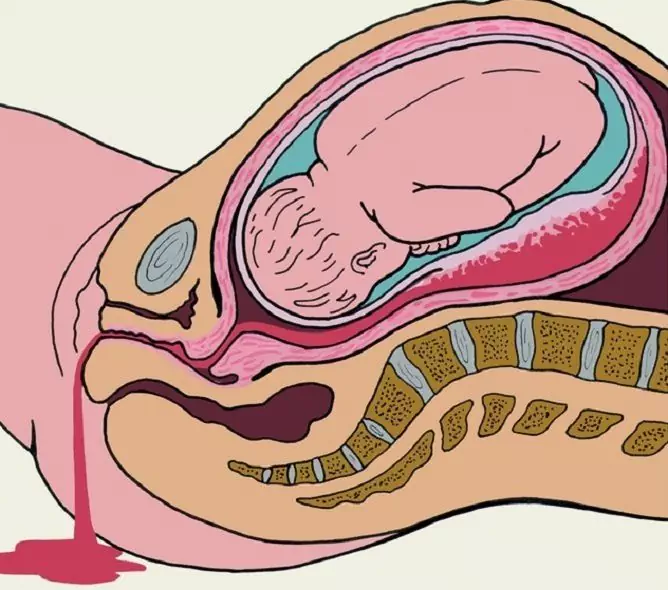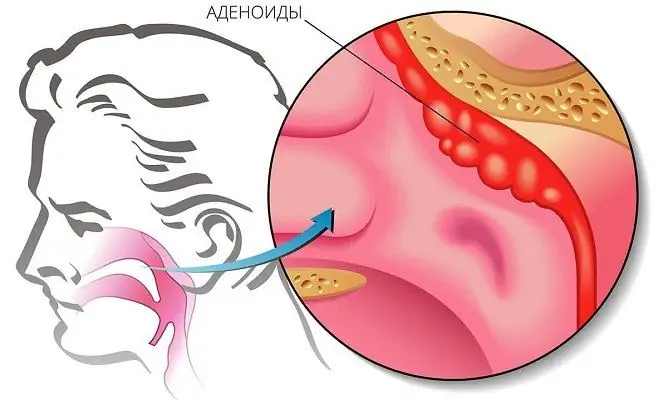- Author Rachel Wainwright [email protected].
- Public 2023-12-15 07:39.
- Last modified 2025-11-02 20:14.
Anuria
The content of the article:
- Causes
- Kinds
- Signs
- Diagnostics
- Treatment of anuria
- Consequences and complications
- Prevention of anuria
Anuria is a clinical symptom inherent in many diseases and pathological conditions. It consists in the absence of urine flow into the bladder while maintaining an adequate water load. The daily urine output in anuria does not exceed 50 ml, that is, less than 2 ml of urine enters the bladder per hour.

With anuria, the daily urine output does not exceed 50 ml
Anuria should be distinguished from acute urinary retention. In the latter case, the bladder fills with urine, and the lack of urination is associated with an obstruction of its outflow. With anuria, the bladder is empty, since urine is either not excreted by the kidneys, or does not enter it due to blockage of the ureters.
Anuria is a potentially life-threatening condition that requires prompt and adequate treatment.
Causes
The reasons leading to the development of anuria are divided into the following groups:
- arena;
- prerenal;
- renal;
- post-renal;
- reflex.
Arenal anuria is extremely rare. It develops in newborns with congenital bilateral aplasia (absence) of the kidneys. In the first day of life in newborns, urination may be absent and normal. But if on the second day the baby does not urinate, it is necessary to urgently conduct an examination in order to find out the reason. Most often, the absence of urination in newborns is not caused by anuria, but by congenital urethral valves or synechiae (thin adhesions) in the area of the external opening of the urethra, that is, in fact, it is an acute urinary retention.
The cause of prerenal anuria is the cessation or significant deterioration of blood flow in the renal artery system. This can lead to:
- severe form of heart failure, accompanied by massive peripheral edema, as well as the accumulation of fluid in the body cavities (ascites, hydrothorax, effusion pericarditis);
- embolism or thrombosis of the renal arteries;
- inferior vena cava thrombosis;
- malignant neoplasms of the retroperitoneal space;
- dissecting aortic aneurysm;
- eclampsia;
- profuse blood loss (postpartum, traumatic).
Decrease in systolic blood pressure less than 50 mm Hg. Art., which is observed in different types of shock (hemorrhagic, anaphylactic, cardiogenic, traumatic), leads to the cessation of renal perfusion and thereby contributes to the development of anuria.

The causes of anuria can be pathological processes occurring in the renal tissues.
The causes of anuria, which consist in pathological processes proceeding directly in the renal tissue, are renal. These are the terminal stages of kidney disease (chronic pyelonephritis, chronic glomerulonephritis, nephroangiosclerosis), bilateral renal tuberculosis, polycystic disease, primary and secondary shriveled kidneys. Also, the renal causes of anuria include:
- acute glomerulonephritis;
- poisoning with poisons and drugs (vinegar essence, mercuric chloride);
- massive hemolysis of erythrocytes due to hemolytic anemia, transfusion of incompatible blood;
- extensive burns;
- massive crushing of muscles.
Absorption of tissue decay products after septic childbirth, abortion, after major surgical interventions is also a renal cause of anuria.
The development of anuria can also lead to the intake of sulfa drugs, provided that there is insufficient fluid intake. In this case, sulfonamide crystals are formed in the renal tubules, which completely block their lumen, thereby blocking the process of urine formation.
Postrenal causes of anuria include obstruction of the ureters by calculi or compression of them with scars, inflammatory infiltrates or a tumor (scar-sclerosing process after radiation therapy, cancer of the sigmoid or rectum, cancer of the bladder or prostate gland, metastases in the retroperitoneal lymph nodes, malignant ovarian tumors or uterus).
Reflex anuria occurs when, under the influence of strong stimuli on the central nervous system, reflex inhibition of urination develops. Such stimuli include roughly performed instrumental interventions (cystoscopy, bougienage of the urethra), sudden cooling of the body. When one ureter is blocked by calculus, the second kidney, under the influence of the renorenal reflex, can also stop its functions.
Kinds
Anuria, depending on the cause that caused it, is divided into arena, prerenal, renal, postrenal and reflex. The prerenal and renal forms are called secretory, since they stop the formation of urine in the kidneys. The postrenal form is excretory due to the obstruction of the flow of urine into the bladder.
Signs
The main symptom of anuria is the cessation of urine separation, combined with a lack of urge to urinate. If the cause of anuria is not identified and eliminated, after 2-3 days the patient shows signs of renal failure:
- increased thirst;
- nausea;
- vomiting;
- itchy skin;
- dry mouth;
- headache.
In the body, nitrogenous slags are formed in large quantities, which are the decay products of protein molecules, as well as non-volatile organic acids; accumulate chlorides, potassium. The water-salt balance suffers significantly and metabolic acidosis develops, that is, the pH of the blood shifts to the acidic side.

The main symptom of anuria is the cessation of urine separation.
In the future, azotemic intoxication is replaced by the development of uremia. At this stage, other signs join the symptoms of anuria:
- growing weakness;
- smell of ammonia from the mouth;
- disturbances of consciousness;
- dyspnea
- swelling;
- diarrhea;
- nausea and vomiting.
Diagnostics
In the absence of urination, a differential diagnosis is made between anuria and acute urinary retention. The following pathological conditions can lead to acute urinary retention:
- spasm of the sphincter of the bladder;
- vulvovaginitis;
- balanoposthitis;
- urethral injury;
- phimosis;
- stones restrained in the urethra;
- some diseases of the central nervous system;
- adenoma or prostate cancer;
- paraproctitis;
- acute prostatitis.
For the purpose of differential diagnosis between these two conditions, bladder catheterization is performed. With anuria, there is no urine in the bladder, or a small amount of it is released, literally a few drops. With acute urinary retention, a large volume of urine is excreted.

Bladder catheterization differentiates anuria from other pathologies
Treatment of anuria depends on its form, so it is very important to identify the exact cause of the pathology. It is possible to assume blockage of the ureter by calculus if there is an indication of the presence of urolithiasis, especially renal colic, a previous state of anuria. Compression of the ureters by tumors of the pelvic organs is usually accompanied by the development of persistent pain syndrome. In the diagnosis of the excretory form of anuria, ultrasound, computed and magnetic resonance imaging are used. Before signs of renal failure appear, excretory urography may be performed to identify the cause of the anuria.
In patients with ischemic heart disease, atherosclerosis, arterial hypertension, congenital and acquired heart defects, endocarditis, who have had a previous stroke or heart attack, it is possible to assume the renal form of anuria, the development of which is caused by thrombosis in the renal vascular basin.
With anuria, changes in the biochemical blood test quickly appear. The concentration of urea (the norm is 2.9-7.5 mmol / l) and creatinine (the norm for women is 44-80, for men is 74-110 mmol / l), medium molecules (in the norm is 0.24 ± 0.04 conventional units).
Treatment of anuria
Treatment of anuria is determined by its type. With the secretory form, drug therapy is aimed at maintaining cardiac activity, normalizing vascular tone, and restoring normal blood pressure levels. With significant blood loss at the prehospital stage, it is temporarily stopped (application of a tourniquet, clamping of the abdominal aorta with a fist, vaginal tamponade), after which the intravenous infusion of solutions of crystalloids and colloids is started. Patients are hospitalized in the intensive care unit. If there are indications in stationary conditions, surgical hemostasis is performed, hemo- and plasma transfusions are performed.
With the obstructive form of anuria, treatment is in most cases surgical. Patients are admitted to the urology or surgery department where ureteral catheterization or drainage into the renal pelvis is performed in order to restore normal passage of urine from the kidneys to the bladder or drainage bag.
Treatment of renal anuria caused by acute renal failure, septic conditions, hemolytic poisoning is carried out in extracorporeal detoxification units equipped with the necessary equipment for hemodialysis or peritoneal dialysis.

Hemodialysis is used to treat renal anuria due to renal failure
In cases where anuria is caused by chronic heart and kidney diseases, patients are hospitalized in the therapeutic department of the hospital, where they are treated to restore the impaired functions.
Consequences and complications
The development of anuria indicates a serious impairment of renal excretory function. If it is not restored in a short time, the body becomes intoxicated with products of protein metabolism and the uremic syndrome develops.
Severe uremia has a negative effect on the function of neurons in the cerebral cortex, which is accompanied by the development of a number of neurological symptoms. If uremia does not respond to correction, a uremic coma develops. This is a serious condition in terms of prognosis. In many cases, uremic coma is fatal, and if the patient can be removed from it, neurological deficit of varying severity often remains.
Prevention of anuria
Prevention of anuria involves the timely diagnosis and treatment of diseases of the kidneys and organs of the cardiovascular system. It is important to observe the drinking regime, especially in the hot season or against the background of conditions accompanied by a significant loss of fluid (diarrhea, indomitable vomiting, hyperthermia). If alarming symptoms appear, you should immediately contact a narrow specialist (nephrologist, urologist).

Elena Minkina Doctor anesthesiologist-resuscitator About the author
Education: graduated from the Tashkent State Medical Institute, specializing in general medicine in 1991. Repeatedly passed refresher courses.
Work experience: anesthesiologist-resuscitator of the city maternity complex, resuscitator of the hemodialysis department.
The information is generalized and provided for informational purposes only. At the first sign of illness, see your doctor. Self-medication is hazardous to health!






